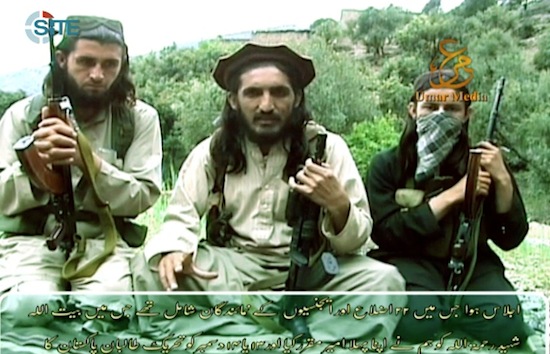 Omar Khalid al Khorasani, from a 2012 propaganda video in which he called for the establishment of a global caliphate and said he wanted to take possession of Pakistan’s nuclear arsenal. Image from the SITE Intelligence Group.
Omar Khalid al Khorasani, from a 2012 propaganda video in which he called for the establishment of a global caliphate and said he wanted to take possession of Pakistan’s nuclear arsenal. Image from the SITE Intelligence Group.
Two Taliban groups that had split last year over a leadership dispute, and the Lashkar-e-Islam, another jihadist group that operates in the tribal areas, have united and re-formed the Movement of the Taliban in Pakistan.
The announcement of the re-unification of the two large factions of the jihadist group, one led by Omar Khalid Khorasani and the other by Mullah Fazlullah, and the merger with Lashkar-e-Islam was announced today by Ihsanullah Ihsan, the spokesman for one of the factions, which is known as Jamaat-ul-Ahrar.
“We congratulate the Ummat-e-Muslima [the Muslim community] in common and especially the Mujahideen of Pakistan for the coalition of strong Jihadi groups, Tehreek-e-Taliban [Movement of the Taliban] Pakistan Jamaat ul Ahrar, Tehreek-e-Lashkar-e-Islam and Tehreek-e-Taliban on one name Tehreek-e-Taliban Pakistan against the Taghooti [satanic], Infidel, Democratic, unIslamic system and the Na-Pak Murtad [a Muslim who rejects Islam] Army,” Ihsan said.
The decision to reform the Movement of the Taliban in Pakistan was made after Khorasani, Fazlullah, and Mangal Bagh, the emir of Lashkar-e-Islam, met for “a joint consultative meeting,” according to Ihsan. The location of the meeting was not disclosed.
The emir for the new group has not been named and likely has not been chosen. According to Ihsan, “An organizing committee was formed which will form a central supreme Shura (Rehbari [Shura) and an organizing body in few days.”
The merger between Khorasani and Fazlullah’s factions indicates that leadership disputes, which came to the fore after Fazlullah took control of the group in the wake of Hakeemullah Mehsud’s death in a US drone strike in Novemebr 2013, have been partially healed. There was much acrimony after Fazlullah was appointed the group’s emir, as the leadership position has traditionally been held by Taliban commanders from the Mehsud tribe in South Waziristan.
It is unclear if the two Mehsud factions, led by Sajna and Sheheryar Mehsud, are in talks to rejoin the Movement of the Taliban in Pakistan.
Lashkar-e-Islam’s merger with the Movement of the Taliban in Pakistan is unsurprising, as the Khyber-based group which also fights in Afghanistan has allied with the Taliban in the past.
Movement of the Taliban in Pakistan suffered several defections in 2014
Khorasani’s Jamaat ul Ahrar faction, which includes Taliban groups from the tribal agencies of Mohmand, Bajaur, Khyber, and Arakzai, and the districts of Charsadda, Peshawar, and Swat, split from Fazlullah’s Movement of the Taliban in Pakistan in late August 2014. At the time, the emir of the group claimed that “the leadership of the Movement of the Taliban in Pakistan is “a victim of narrow, personal objectives.” Ihsanullah told The Long War Journal at the time that the then newly formed Jaamat-ul-Ahrar is “separate from the TTP [Movement of the Taliban in Pakistan leadership.” [See LWJ reports, Jaamat-ul-Ahrar is ‘separate from the TTP leadership,’ spokesman says and Taliban splinter group Jamaat-ul-Ahrar forms in northwestern Pakistan.]
The Movement of the Taliban in Pakistan suffered several significant defections in 2014, which greatly reduced the group’s power and influence in northwestern Pakistan and beyond. The first group that split from the Movement of the Taliban in Pakistan was led by Maulana Umar Qasmi, who opposed peace negotiations with the Pakistani government. Qasmi formed Ahrar-ul-Hind in February 2014; his group merged with Jaamat-ul-Ahrar in August 2014.
A Taliban faction in South Waziristan that is led by Sajna Mehsud broke from the Taliban alliance in May 2014. The spokesman for the Sajna’s faction, which is called the Movement of the Taliban – Mehsud, accused its parent organization of being “un-Islamic.”
In mid-September, another faction in North Waziristan led by Sheheryar Mehsud, who was loyal to Hakeemullah and Baitullah Mehsud, the leaders of the Movement of the Taliban in Pakistan prior to Fazlullah’s takeover, also broke away. The group “declared extortion, kidnapping for ransom, and bombing public places as ‘Haram’ (forbidden by Islam),” according to Pakistan Today. [For more information on the Movement of the Taliban in Pakistan’s split in 2014, see LWJ report, Discord dissolves Pakistani Taliban coalition.]








2 Comments
What exactly does this mean to form another caliphate? How many Caliphs can there be? One from ISIS, Erdogan?
Good information, no surprise here. Look for these ‘guys’ to have another ‘dispute’ at some point in time then revisit the whole process all over again. Typical cycle in Tribal Diplomacy.
1 Trackback